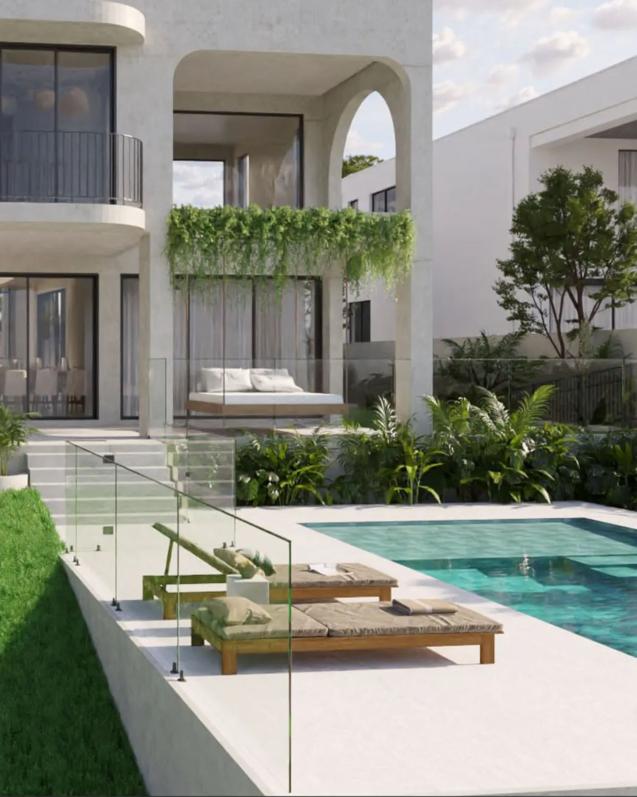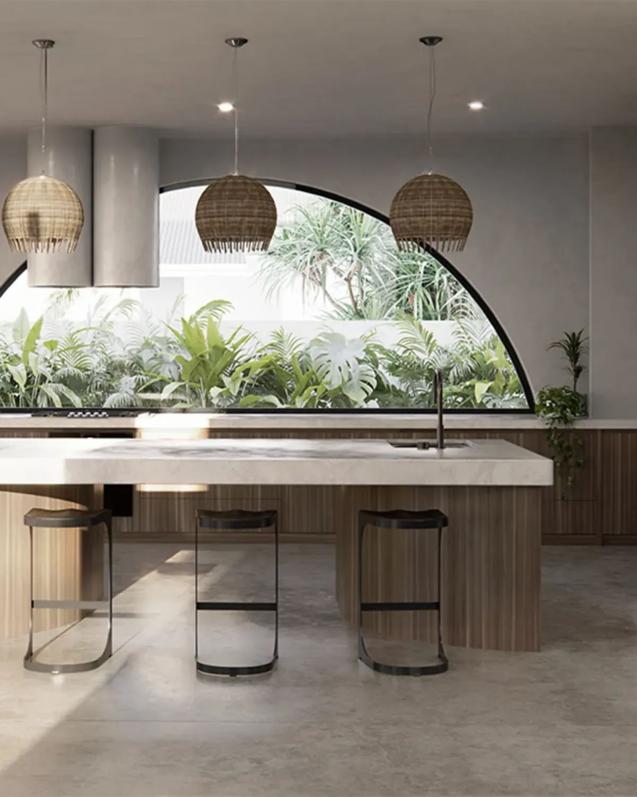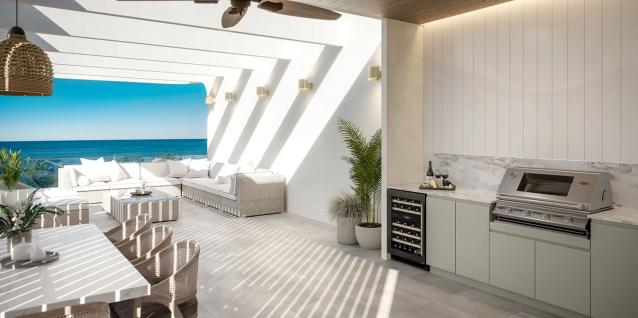
How to Choose Your Dream House Plan
By Unique Built|February 22, 2024
The line between daydreams and blueprints for custom home building isn't just drawn with a pencil. Here at Unique Built, we understand that choosing your dream house plan is a bit like finding the perfect pair of shoes - it needs to fit just right, be comfortable, and, let's face it, make your neighbours a tad envious. But before you start dreaming of infinity pools and secret passages, let’s talk brass tacks.
You see, creating a home that mirrors your deepest desires while also shaking hands with the realities of physics, budgets, and local council zoning laws, is an art. It's about striking a balance – a delicate dance between "Wow, I never thought of that!" and "How are we going to make this work?"
We're here not just as builders but as guides, helping you through this exciting journey. Our approach is a blend of professional wisdom peppered with enthusiasm, and a knack for translating engineer-speak into human. We believe in a world where technical precision and creative dreaming coexist, and we’re pretty good at speaking both languages.
Understanding Your Needs
On one side, we have the 'needs', the must-haves for your home to be functional and liveable; on the other, the 'wants', those fancy features that make your heart race. The trick is finding the sweet spot where practicality meets desire without causing a head-on collision with reality.
The Essential Elements
What are those non-negotiables?
These are your essentials – like the number of bedrooms to accommodate your family, a workable kitchen, or accessibility features. Think about the structure of your day-to-day life. Do you work from home and need a quiet office space? Maybe you're a culinary enthusiast needing a kitchen that's more than just a microwave and a fridge. These are your 'needs', and they form the backbone of your dream house.
The Extras
Now, onto the 'wants'. We're talking about that wine cellar you've always dreamed of, the home theatre, or perhaps the Olympic-sized swimming pool. These are fantastic, no doubt, but they fall into the 'luxury' category. It's about understanding that while a Jacuzzi sounds great, will it gather dust because, let's face it, you're not really a bath person?
Balancing the Scales
So, how do you strike a balance? It's a bit like grocery shopping on a budget.
You need the essentials – bread, milk, eggs. But hey, that fancy chocolate bar is calling your name. The key is prioritisation. If the budget allows, why not? But if it's a choice between the home office you'll use daily and a sauna you might use twice a year, the choice becomes clearer.
Reality Check
The quest to build your dream house is thrilling, but here's a splash of cold water (or should we say reality?) – dreams need a sturdy foundation of practicality.
You, future homeowner or engineer extraordinaire, are about to embark on a journey akin to tightrope walking. On one side, there's a pit of 'wishful thinking', and on the other, the abyss of 'hard truths'. Striking a balance is key. It’s about meshing what you want (a slide from the bedroom to the living room, perhaps?) with what’s actually doable (like, will your pet even enjoy that slide?).
The Dreamer’s Dilemma
We've all been there – eyes glazing over glossy home design magazines, picturing ourselves sipping a drink in that sun-drenched atrium. But let's park the daydreams for a second. The reality? That atrium could turn your living room into a sauna come summer. Not so dreamy now, huh? It's crucial to temper those grand visions with a dollop of realism.
Pragmatism
Assessing your personal and financial readiness isn't just a box-ticking exercise; it's the cornerstone of your dream home. It's about asking the hard questions: Can I really afford a moat? Do I need a room just for my hat collection? It's time to align your heart's desires with your wallet’s capabilities.
With modern technology tools like 3D modelling, the bridge between what's in your head and what's possible has never been shorter.
Embrace the Power of 3D Modelling
3D modelling is a game-changer in home planning. Gone are the days of trying to decipher complex blueprints or struggling to visualise your future abode from a flat floor plan. 3D modelling takes the guesswork out of the equation. It's like having a crystal ball, but instead of vague predictions, you get a detailed, tangible peek into your future home.
How 3D Modelling Works for You
As a homeowner, you might not be fluent in architect-speak, but with 3D models, you don’t have to be. These tools allow you to see your home in intricate detail – from the way natural light dances through your living room to how the kitchen island fits with your dining area. For the engineers among us, it’s a chance to delve into the specifics: analysing angles, dimensions, and materials with precision.
Using 3D modelling software, you can virtually walk through your home, make real-time modifications, and see the impact immediately. Wondering if that bay window should be a bit bigger? Try it out! Not sure about the wall colour? Change it with a click! It’s like playing a highly sophisticated version of your favourite simulation game, except this time, the result is your real home.
Making the Most of 3D Technology
To harness the full potential of 3D modelling, start by exploring different software options. Some are user-friendly enough for beginners, while others might require a bit of a learning curve. Don’t shy away from seeking professional help to navigate this tech. After all, it’s about making your dream home a reality, not mastering software.
Once you have your tool of choice, the real fun begins. Play around with designs, textures, and layouts. This is your canvas to paint your lifestyle, needs, and personality onto your future home. And for our engineering friends, this is where your technical prowess can shine – scrutinise every detail, from load-bearing walls to energy efficiency.
Bringing Dreams to Reality
Now, let’s get real for a moment. While 3D modelling is a powerful tool, it’s important to ground these virtual dreams in reality. Always keep in mind factors like budget, feasibility, and local building codes. Use this technology not just to envision the fanciest version of your home but to create a plan that is as practical as it is beautiful.
Sustainability and Efficiency
In the quest to build your dream home, there's a green elephant in the room, and it's not just about choosing the right shade of paint for your living room. We’re talking about sustainability, and before you roll your eyes, hear us out.
Going green in your home design is not just a noble gesture for Mother Earth; it's a smart move for your wallet and well-being in the long haul.
The Real Deal on Eco-Friendly Designs
When you think eco-friendly, you might picture a house that looks more like a science project than a home. But, let's set the record straight. Sustainable homes have come a long way from the ‘hippie’ stereotypes. Today, they're all about efficiency, aesthetics, and yes, saving you some greenbacks over time.
Tips for a Sustainable Home
Investing in green features might seem like a hefty upfront cost, but here's the kicker – it pays off in the long run. Energy-efficient appliances, for example, might cost more initially, but they reduce your utility bills every month. It's like putting money in a piggy bank every time you don't have to crank up the heat or switch on the air conditioning.
Plus, there's the often-overlooked value of a healthier living environment. Materials with low volatile organic compounds (VOCs), natural light, and improved air quality all contribute to a home that’s not just a living space, but a wellness space.
Tailoring Your Space - The Unique Built Way
In the world of custom home building, 'personalisation' is the cornerstone of every project we undertake at Unique Built.
How does this concept transform from a mere idea into the walls and windows of your future home?
Customisation in Home Design
First things first, personalisation in home design is more than choosing paint colours or kitchen tiles (though, admittedly, those are pretty fun decisions to make). It's about weaving your personality, lifestyle, and even your quirks into the very fabric of your home. You know, that secret bookcase door you've always wanted? It's not just a whimsical fancy; it's a reflection of your love for mysteries and adventure.
At Unique Built, we see personalisation as a collaborative art. It's not about imposing our ideas on you; it's about listening, understanding, and then crafting a space that's as unique as your fingerprint. And yes, while we're at it, let's make the neighbours a little jealous, shall we?
Reflecting Your Personality in Your Home
Now, let's talk about you. How do you infuse your home with your personality?
It starts with introspection. What are your hobbies? Are you a culinary enthusiast needing a state-of-the-art kitchen, or a yoga practitioner who'd love a tranquil meditation corner? Your home should be a testament to your life, your passions, and yes, even those little idiosyncrasies that make you, well, you.
We at Unique Built are not just builders; we're dream weavers. And when we say 'custom-designed homes,' we mean every word of it. It's not about fitting you into a pre-designed plan; it's about crafting a plan that fits you. So, whether you're a homeowner dreaming of a cosy nest or an engineer with an eye for precision and functionality, we're here to translate those dreams into concrete (sometimes literally) reality.
If you’d like to learn more about custom home designs or like the idea of building on your existing property, speak to us today about a Brisbane knock down rebuild.
You see, creating a home that mirrors your deepest desires while also shaking hands with the realities of physics, budgets, and local council zoning laws, is an art. It's about striking a balance – a delicate dance between "Wow, I never thought of that!" and "How are we going to make this work?"
We're here not just as builders but as guides, helping you through this exciting journey. Our approach is a blend of professional wisdom peppered with enthusiasm, and a knack for translating engineer-speak into human. We believe in a world where technical precision and creative dreaming coexist, and we’re pretty good at speaking both languages.
Understanding Your Needs
On one side, we have the 'needs', the must-haves for your home to be functional and liveable; on the other, the 'wants', those fancy features that make your heart race. The trick is finding the sweet spot where practicality meets desire without causing a head-on collision with reality.
The Essential Elements
What are those non-negotiables?
These are your essentials – like the number of bedrooms to accommodate your family, a workable kitchen, or accessibility features. Think about the structure of your day-to-day life. Do you work from home and need a quiet office space? Maybe you're a culinary enthusiast needing a kitchen that's more than just a microwave and a fridge. These are your 'needs', and they form the backbone of your dream house.
The Extras
Now, onto the 'wants'. We're talking about that wine cellar you've always dreamed of, the home theatre, or perhaps the Olympic-sized swimming pool. These are fantastic, no doubt, but they fall into the 'luxury' category. It's about understanding that while a Jacuzzi sounds great, will it gather dust because, let's face it, you're not really a bath person?
Balancing the Scales
So, how do you strike a balance? It's a bit like grocery shopping on a budget.
You need the essentials – bread, milk, eggs. But hey, that fancy chocolate bar is calling your name. The key is prioritisation. If the budget allows, why not? But if it's a choice between the home office you'll use daily and a sauna you might use twice a year, the choice becomes clearer.
Reality Check
The quest to build your dream house is thrilling, but here's a splash of cold water (or should we say reality?) – dreams need a sturdy foundation of practicality.
You, future homeowner or engineer extraordinaire, are about to embark on a journey akin to tightrope walking. On one side, there's a pit of 'wishful thinking', and on the other, the abyss of 'hard truths'. Striking a balance is key. It’s about meshing what you want (a slide from the bedroom to the living room, perhaps?) with what’s actually doable (like, will your pet even enjoy that slide?).
The Dreamer’s Dilemma
We've all been there – eyes glazing over glossy home design magazines, picturing ourselves sipping a drink in that sun-drenched atrium. But let's park the daydreams for a second. The reality? That atrium could turn your living room into a sauna come summer. Not so dreamy now, huh? It's crucial to temper those grand visions with a dollop of realism.
Pragmatism
Assessing your personal and financial readiness isn't just a box-ticking exercise; it's the cornerstone of your dream home. It's about asking the hard questions: Can I really afford a moat? Do I need a room just for my hat collection? It's time to align your heart's desires with your wallet’s capabilities.
- Budget: Start with the unglamorous but essential task of budgeting. This isn't just about how much you can spend, but also about what you should spend on. A crystal-clear budget is your roadmap in the land of home building.
- Needs vs. Wants: Create a list, but check it thrice. Distinguish between 'I absolutely need this' and 'It would be nice to have a chocolate fountain in the foyer'. Prioritise your needs, and if the budget allows, sprinkle in your wants.
- Future-Proofing: Think ahead. Will your dream home stand the test of time? Or will it end up like that pair of neon pants you thought you’d wear forever? Consider how your needs might evolve over time.
- Expert Consultation: Don’t shy away from seeking advice. Architects, financial advisors, even that cousin who built a house last year – their insights can be invaluable. They’re the ones who’ll gently nudge you away from impractical ideas (like installing a fish tank as a ceiling).
- Location: Some homeowners wish to build a spectacular new home, but don’t wish to leave the area that they’ve lived in – and loved for so long. In such cases, a Gold Coast knock down rebuild is a great idea.
With modern technology tools like 3D modelling, the bridge between what's in your head and what's possible has never been shorter.
Embrace the Power of 3D Modelling
3D modelling is a game-changer in home planning. Gone are the days of trying to decipher complex blueprints or struggling to visualise your future abode from a flat floor plan. 3D modelling takes the guesswork out of the equation. It's like having a crystal ball, but instead of vague predictions, you get a detailed, tangible peek into your future home.
How 3D Modelling Works for You
As a homeowner, you might not be fluent in architect-speak, but with 3D models, you don’t have to be. These tools allow you to see your home in intricate detail – from the way natural light dances through your living room to how the kitchen island fits with your dining area. For the engineers among us, it’s a chance to delve into the specifics: analysing angles, dimensions, and materials with precision.
Using 3D modelling software, you can virtually walk through your home, make real-time modifications, and see the impact immediately. Wondering if that bay window should be a bit bigger? Try it out! Not sure about the wall colour? Change it with a click! It’s like playing a highly sophisticated version of your favourite simulation game, except this time, the result is your real home.
Making the Most of 3D Technology
To harness the full potential of 3D modelling, start by exploring different software options. Some are user-friendly enough for beginners, while others might require a bit of a learning curve. Don’t shy away from seeking professional help to navigate this tech. After all, it’s about making your dream home a reality, not mastering software.
Once you have your tool of choice, the real fun begins. Play around with designs, textures, and layouts. This is your canvas to paint your lifestyle, needs, and personality onto your future home. And for our engineering friends, this is where your technical prowess can shine – scrutinise every detail, from load-bearing walls to energy efficiency.
Bringing Dreams to Reality
Now, let’s get real for a moment. While 3D modelling is a powerful tool, it’s important to ground these virtual dreams in reality. Always keep in mind factors like budget, feasibility, and local building codes. Use this technology not just to envision the fanciest version of your home but to create a plan that is as practical as it is beautiful.
Sustainability and Efficiency
In the quest to build your dream home, there's a green elephant in the room, and it's not just about choosing the right shade of paint for your living room. We’re talking about sustainability, and before you roll your eyes, hear us out.
Going green in your home design is not just a noble gesture for Mother Earth; it's a smart move for your wallet and well-being in the long haul.
The Real Deal on Eco-Friendly Designs
When you think eco-friendly, you might picture a house that looks more like a science project than a home. But, let's set the record straight. Sustainable homes have come a long way from the ‘hippie’ stereotypes. Today, they're all about efficiency, aesthetics, and yes, saving you some greenbacks over time.
Tips for a Sustainable Home
- Insulation is Your Secret Weapon: Good insulation isn't just about staying cosy in winter. It's about energy efficiency. Opting for high-quality insulation keeps your home's temperature more consistent, meaning less work for your heating and cooling systems and more savings for you.
- Solar Panels Aren’t Just a Trend: They're an investment. With solar technology advancing leaps and bounds, harnessing the sun's power is more accessible than ever. Think long-term gains over short-term costs.
- Water Conservation is Key: Low-flow toilets, rainwater harvesting systems, and drought-tolerant landscaping aren’t just buzzwords. They're smart ways to reduce your water bill and impact on the environment.
- Choose Sustainable Materials: From bamboo flooring to recycled glass countertops, the materials you choose can have a big impact. They’re not only eco-friendly but also durable and can add a unique aesthetic to your home.
- Smart Home Technology: Incorporating smart home technology isn't just about impressing your friends. It's about efficiency. Automated systems for lighting, heating, and cooling can significantly reduce energy consumption.
Investing in green features might seem like a hefty upfront cost, but here's the kicker – it pays off in the long run. Energy-efficient appliances, for example, might cost more initially, but they reduce your utility bills every month. It's like putting money in a piggy bank every time you don't have to crank up the heat or switch on the air conditioning.
Plus, there's the often-overlooked value of a healthier living environment. Materials with low volatile organic compounds (VOCs), natural light, and improved air quality all contribute to a home that’s not just a living space, but a wellness space.
Tailoring Your Space - The Unique Built Way
In the world of custom home building, 'personalisation' is the cornerstone of every project we undertake at Unique Built.
How does this concept transform from a mere idea into the walls and windows of your future home?
Customisation in Home Design
First things first, personalisation in home design is more than choosing paint colours or kitchen tiles (though, admittedly, those are pretty fun decisions to make). It's about weaving your personality, lifestyle, and even your quirks into the very fabric of your home. You know, that secret bookcase door you've always wanted? It's not just a whimsical fancy; it's a reflection of your love for mysteries and adventure.
At Unique Built, we see personalisation as a collaborative art. It's not about imposing our ideas on you; it's about listening, understanding, and then crafting a space that's as unique as your fingerprint. And yes, while we're at it, let's make the neighbours a little jealous, shall we?
Reflecting Your Personality in Your Home
Now, let's talk about you. How do you infuse your home with your personality?
It starts with introspection. What are your hobbies? Are you a culinary enthusiast needing a state-of-the-art kitchen, or a yoga practitioner who'd love a tranquil meditation corner? Your home should be a testament to your life, your passions, and yes, even those little idiosyncrasies that make you, well, you.
We at Unique Built are not just builders; we're dream weavers. And when we say 'custom-designed homes,' we mean every word of it. It's not about fitting you into a pre-designed plan; it's about crafting a plan that fits you. So, whether you're a homeowner dreaming of a cosy nest or an engineer with an eye for precision and functionality, we're here to translate those dreams into concrete (sometimes literally) reality.
If you’d like to learn more about custom home designs or like the idea of building on your existing property, speak to us today about a Brisbane knock down rebuild.



